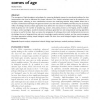Free Online Productivity Tools
i2Speak
i2Symbol
i2OCR
iTex2Img
iWeb2Print
iWeb2Shot
i2Type
iPdf2Split
iPdf2Merge
i2Bopomofo
i2Arabic
i2Style
i2Image
i2PDF
iLatex2Rtf
Sci2ools
BIB
2010
2010
Knowledge-based data analysis comes of age
The emergence of high-throughput technologies for measuring biological systems has introduced problems for data interpretation that must be addressed for proper inference. First, analysis techniques need to be matched to the biological system, reflecting in their mathematical structure the underlying behavior being studied. When this is not done, mathematical techniques will generate answers, but the values and reliability estimates may not accurately reflect the biology. Second, analysis approaches must address the vast excess in variables measured (e.g. transcript levels of genes) over the number of samples (e.g. tumors, time points), known as the ‘large-p, small-n’ problem. In large-p, small-n paradigms, standard statistical techniques generally fail, and computational learning algorithms are prone to overfit the data. Here we review the emergence of techniques that match mathematical structure to the biology, the use of integrated data and prior knowledge to guide statistical ...
| Added | 12 Jan 2011 |
| Updated | 12 Jan 2011 |
| Type | Journal |
| Year | 2010 |
| Where | BIB |
| Authors | Michael F. Ochs |
Comments (0)

